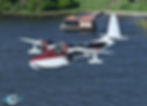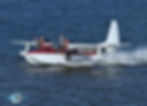Grumman G-73 Mallard
- J.K. Caldwell
- Aug 3
- 5 min read

First Impressions: What’s not to love about a luxurious flying boat that can whisk you and 9 friends away to adventurous, exotic destinations like remote lakes, or white sand beaches that beckon from below as you pass overhead? We aviators can be defined, in part, as adventurers. The iconic Grumman G-73 Mallard takes that aviation adventure to a whole new level, blending utility with the romance of the flying boat era.
Background: The Grumman Mallard was a post-war design that was intended to capitalize on the success of the Widgeon (G-44) and the Goose (G-21). Debuting in 1946, the G-73 Mallard was approximately 34% larger than the Goose and had a notably longer range (1,200 NM vs 556 NM). Designed as a commuter and charter aircraft for coastal communities, it quickly captured the attention of wealthy individuals and corporations who valued its versatility and ability to access private estates, marinas, or isolated vacation sites. Its spacious cabin and relatively long-range made it an attractive alternative to land-based aircraft. Many Mallards were even outfitted with luxurious interiors, complete with plush seating, tables, and custom cabinetry that transformed them into flying yachts.
The last and largest of the Grumman flying boats was the HU-16 Albatross. It was approximately 70% larger than the Mallard and was marketed primarily to militaries for open water Search & Rescue. The G-111 Albatross was a later design modification of the ex-military HU-16s. That retrofit turned it into a 28-seat amphibious airliner. Of all Grumman’s aquatic birds (Duck, Widgeon, Goose, Mallard, and Albatross), only the Mallard had no military application, cementing its identity as a civilian explorer’s dream machine. There was a total of 59 G-73s built before production ceased in 1951. Since then, most of the survivors have been converted to PT-6A turboprops with a “Frakes Conversion.”
Jack Bart of Bridgeport, CT, who has a legendary history himself in the music management business (mainly Motown), owns one of the rare Mallards that still wears the original round engines. Owner of serial number J18, a 1947 G-73, for over 30 years, Bart has flown it up and down the eastern seaboard innumerable times as he enjoyed exploring many lakes and spectacular waterways along the way. One of his favorite summertime “Mallard missions” is taking friends to lunch and then to a scenic lake for a refreshing swim. His Mallard is equipped with luxury executive seating for nine (including pilot) and has a sideways-facing couch and entertainment center/bar cabinet in the mid cabin and lavatory in the aft cabin.

Design and Systems: The Mallard’s design is a testament to Grumman’s engineering prowess at balancing the demands of amphibious operations with the comforts of a long-range cruiser. Its hydraulic system is a critical component, controlling the landing gear, flaps, cowl flaps, and, somewhat quirkily, the windshield wipers. A separate hydraulic braking system, operated by master cylinders linked to the pilot’s rudder pedals, allows ground steering by nudging the castoring nosewheel in the desired direction. A centering mechanism engages after weight is off the nosewheel, allowing proper retraction.
Powering the Mallard are two nine-cylinder, 600-horsepower Pratt & Whitney R-1340 radial engines, each driving three-bladed Hamilton Standard full-feathering, hydromatic constant-speed propellers. These robust engines provide the thrust necessary for both water and land operations, and deliver reliable performance across a variety of conditions. The aircraft’s high-wing design, paired with its bulbous nose and twin sponsons, gives it a distinctive silhouette that is as functional as it is iconic, providing stability on water and lift in the air.

Landing (terra firma): The landing gear can be extended below 150 mph and flaps set incrementally (10, 30, 45) below 120 mph. The gear is checked down and locked in a variety of ways. The “wheels down” indicator on the right side of the instrument panel displays three “tire tread” depictions that can be backed up by checking mirrors on both sponsons for visual assurance that all three landing gear appear down.
A small light in each wheel well illuminates the gear at night. Additionally, a red painted stripe on the main landing gear legs, visible from the cockpit by looking back from the side windows, must be vertically aligned. The nose gear can be checked down by viewing the position of a yellow tab through a floorboard plexiglass window in front of the copilot’s feet. If all these confirmations aren’t enough, there is also a round plexiglass porthole in the floorboard in the bow compartment to enable the copilot to see whether the nose tire is up in the well or down.
Emergency extension of the landing gear would typically mean a loss of hydraulic pressure. The engine-driven hydraulic system operates off the left engine, so if that engine is not operational or if the mechanical pump has failed, a manual wobble pump (behind the copilot’s seat) can lower the landing gear. But first the selector handle/valve must be positioned correctly to direct the hydraulic fluid to either the flaps or the landing gear. If the hydraulic fluid has been lost, the landing gear extension procedures start to get interesting. Should it prove necessary, a crewmember, broomstick in hand, can push the main landing gear out and locked from removable cabin porthole windows! Lesson: always carry a broom when flying a Mallard!
Final approach speed will be between 90 to 100 mph, slowing to 85 mph over the threshold. The large rudder provides plenty of yaw authority until taxi speeds, where some differential throttles and braking are required.

Water Landing: The large wings (444 square feet), powerful engines, and deep V hull make the Mallard a capable flying boat, even with wave heights up to 2½ feet. For even tighter turns than differential engine thrust can provide during water taxi, the main landing gear can be raised and lowered individually from valve mechanisms behind both the pilot and copilot seats, providing differential hydrodynamic drag. Once on the water, the Mallard can be beached, ramped, moored, or docked. The right rudder pedals can be folded down and the right control yoke unlocked and pivoted over. This will allow access to crawl under the right dashboard and open a bow hatch on the nose, so the first mate (copilot) can then toss the anchor out. Now it’s time to enjoy a swim or even inflate a small dinghy and go exploring!

Flight Characteristics: The Mallard is a flying amphibious boat; as such, it flies as one would imagine (like a boat with wings). It is a stable machine with heavy flight controls, and it requires deliberate inputs, but it is not unwieldy. Four wing tanks collectively hold 380 gallons of fuel and the twin R-1340s collectively burn 60 gallons per hour while traveling about 160 to 170 miles per hour. From the cockpit, it’s simple to visually monitor engine health because they hang on the wings right behind you. As with many flying boats, the Grumman Mallard’s engine controls (throttles, propeller, and mixture settings) are mounted on the overhead panel, a straightforward design that’s easy to adapt to (with a little time).

Wrap-Up: Having the opportunity to fly the Mallard for a few hours, including an overwater leg down the East Coast, was an exceptional treat. Sights along the way included the USS Yorktown, Fort Sumter, and a tower-approved low flight down the space shuttle runway at Cape Canaveral. It also brought a heavy dose of nostalgia to pilot a radial engine flying boat over the open seas with no land in sight, and, yes, for a moment I fancied myself a 1930s Pan American Clipper captain dodging thunderstorms while trying to find to a small island in a large ocean.
Though among the rarer Grumman amphibians, the Mallard holds a distinctive place in aviation history, capturing the romance and adventure of the flying boat era. Its ability to travel in luxury, while seamlessly transitioning between land and water operations, still makes it a symbol of freedom and exploration. For both pilots and passengers, it provides a sentimental journey, evoking an time when air travel was an adventure rather than a routine.


.png)
